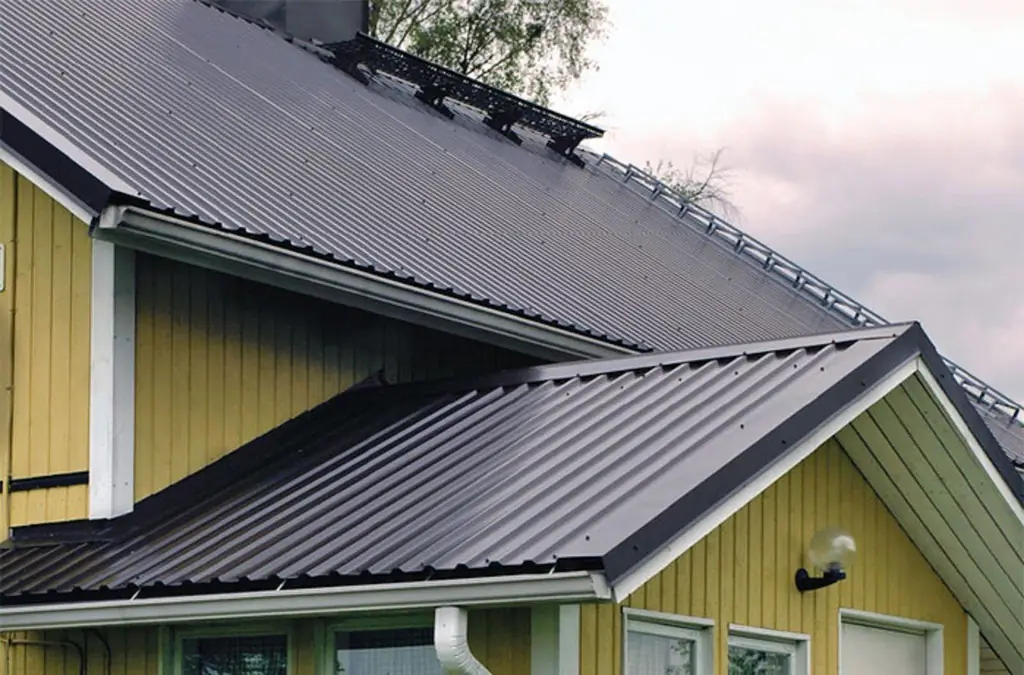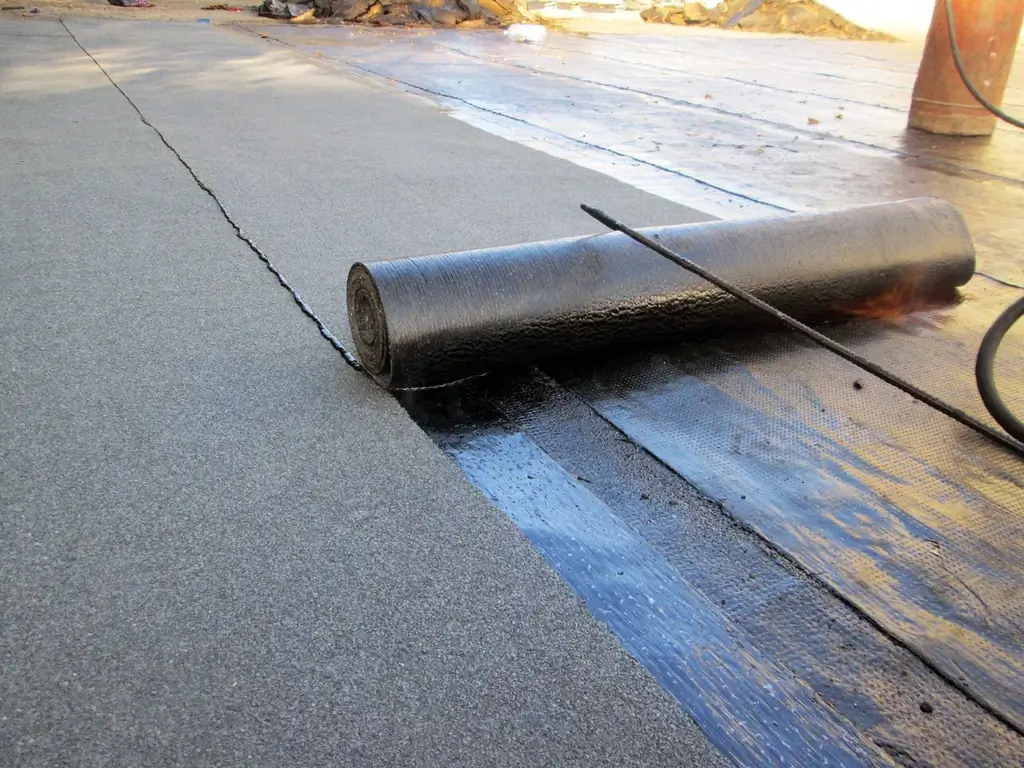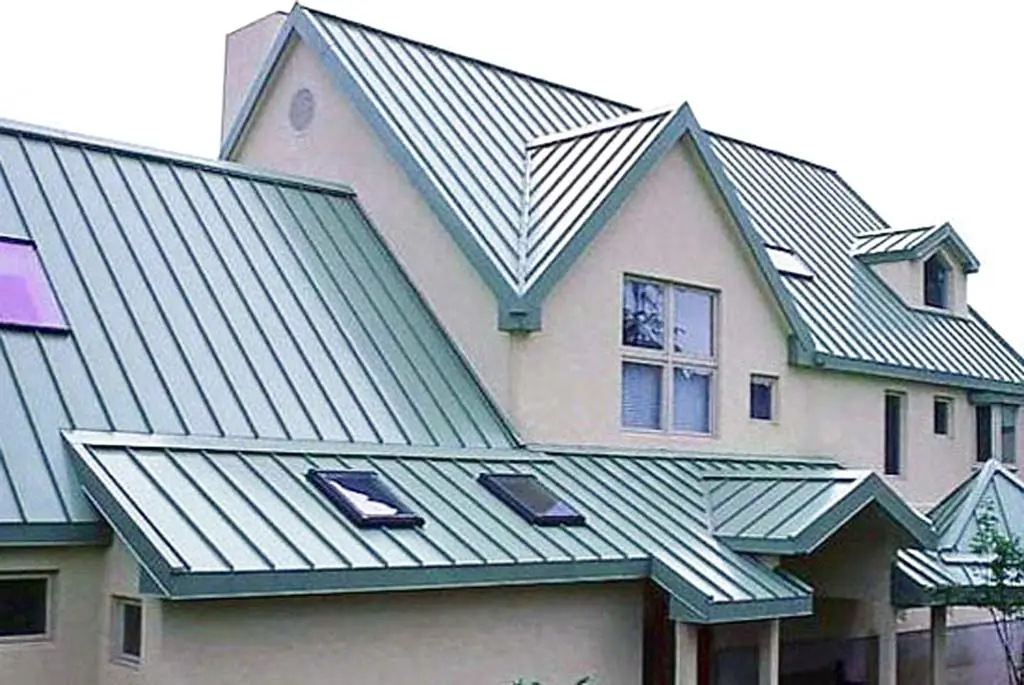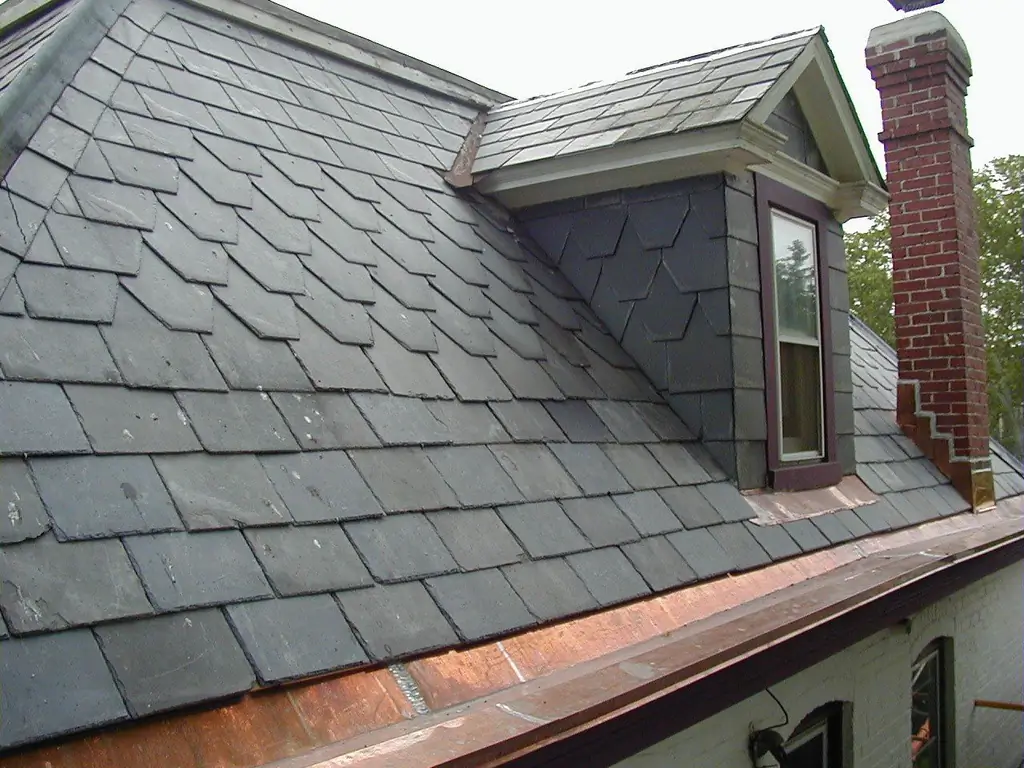
Table of contents:
- Author Bailey Albertson [email protected].
- Public 2023-12-17 12:53.
- Last modified 2025-06-01 07:32.
How to make a roof from a profiled sheet with your own hands: step-by-step instructions and repair features

The use of a profiled sheet for roofing can be considered the most practical solution, because this material is quite easy to maintain and install due to its low weight, aesthetic appearance and affordable price. Moreover, you can lay the profiled sheet on the roof with your own hands, without having special construction skills.
Content
-
1 Roof covering made of profiled sheets
- 1.1 Characteristics of roofing sheeting
-
1.2 Tool for roofing made of profiled sheet
1.2.1 Video: how to cut corrugated board
-
2 Roofing device made of profiled sheet
-
2.1 Cold roof
2.1.1 Video: installation of the crate under the profiled sheet
-
2.2 Insulated roof
2.2.1 Video: DIY installation of a profiled sheet
- 2.3 The minimum angle of inclination of the roof from the profiled sheet
-
-
3 Features of installing a roof from a profiled sheet
-
3.1 Errors when installing corrugated board on the roof
3.1.1 Video: how to fix mistakes when installing corrugated board
-
-
4 Features of the operation of the roof from the profiled sheet
- 4.1 Service life of profile sheets
- 4.2 Repair of roofing sheeting
Roof covering made of profiled sheets
The covering made of corrugated board has significant advantages over other roofing materials. The main advantage is that you can do the installation yourself, while the presence of any specific skills is not required.

A well-chosen and correctly laid profiled sheet will make the appearance of the house very modern and attractive.
Before work, you need to take into account the main parameters of the roof structure, on the basis of which you can draw up a project in advance:
- type of rafter system and step of installation of rafters;
- the angle of inclination of the slopes;
- the specific model of the profiled sheet used.
Characteristics of roofing sheeting
The corrugated board is made of rolled steel. The profiles are formed by cold pressing. After forming, each sheet is covered with a protective zinc layer. Additionally, a decorative and protective layer of paint and varnish can be applied to the products.

Profiled sheets of different models differ in size, thickness, wave height and color
The price of the material also depends on the composition and the presence of a particular coating in the composition of the sheet (painted sheets are more expensive). The professional sheet has a lot of advantages, the main of which are:
- high strength and resistance to atmospheric precipitation and weather conditions;
- ability to withstand increased loads (depends on the number and size of stiffening ribs);
- lack of unpleasant odor;
- the ability to use on roofs with a slope of more than 8 o;
- low weight, due to which minimal pressure will be exerted on the rafter system.

Since corrugated board is produced from blanks of the same size, the width of the sheet depends on the height of the wave of its profile: the higher the wave, the narrower the sheet
Not every profiled sheet is suitable for the roof. As a rule, for this purpose, a material marked "H" (carrier) is selected. The height of the corrugation for such products is 44 mm or more. They can withstand both the mass of a person (in case of repair) and a mass of snow (which is especially important in areas with high precipitation).

For roofing work, a load-bearing corrugated board is usually used, in the marking of which there is the letter "H"
Tool for roofing made of profiled sheet
You can install a profiled sheet with your own hands, but with a special tool. In advance, you need to take care of purchasing at least one cutting device that will not damage the protective layer of the material. This could be:
-
a hacksaw for metal, and for a profiled sheet you can only take a tool with fine teeth;

Hacksaw for metal For corrugated board, only a hacksaw with fine teeth is suitable
- scissors for working with tin;
-
a circular saw for which you need to prepare a carbide-tipped accessory capable of working at high speed;

Circular Saw In no case should you replace a circular saw with a grinder for cutting profiled sheets.
- electric cutter.
Additionally required:
- roulette;
- a hammer;
- cord;
- rail;
- drill with drills.
Video: how to cut corrugated board
Roofing device made of profiled sheet
The sequence of installation of a roof from a profiled sheet depends on the type of its device, in particular, on whether it is intended for a cold or warm attic (in the second case, heat-insulating material is used).
Cold roof
Installation of a roof from a profiled sheet implies the arrangement of a special roofing cake. In the case of a cold roof, the design is much simpler.

If the attic space will not fit into a living room, roof insulation and ventilation gaps are not required
It is mounted in the following sequence:
- Laying waterproofing material. It needs to be laid directly on the rafters with a sag of 2-4 cm. A micro-perforated film is ideal for this purpose. For fixing, you need wooden blocks that will serve as a counter-lattice. They are nailed along the rafters.
-
Installation of battens. For the cold roof of a private house, you can use wooden blocks 40 * 50 or 50 * 50 mm or an edged board with a cross section of at least 20 × 100 mm. Before installation, each element must be carefully treated with antiseptic agents to prevent the decay process.

Cold roof waterproofing The waterproofing material is laid with a slight sag and is fixed with counter battens, and a longitudinal crate is stuffed on top
-
Installation of profiled sheet. Laying begins from one of the lower corners of the ramp. In the event that the roof dimensions do not allow the installation of full-size sheets, they must be cut or laid with a large overlap. This will improve the tightness of the seams. In this case, first, the vertical row is completely laid from the eaves to the ridge and only after that they move on to the next row, starting it again from the bottom. The side joint between the sheets should be equal to 1-2 waves, depending on the angle of inclination of the slopes:
- with a roof slope of up to 10 o, an overlap is made in two waves;
-
on steeper slopes, a single wave overlap is sufficient.

The procedure for fixing sheets of corrugated board The corrugated board is laid in rows from one edge of the eaves to the other so that in each row the sheets are arranged from bottom to top with an overlap of 20 cm
Video: installation of the crate under the profiled sheet
Insulated roof
In the event that a living room will be arranged in the attic, the roof will need to be insulated. But when using a profiled sheet, special requirements are imposed on the thermal insulation material:
- low thermal conductivity: the less it is, the more the insulation is suitable. For roofing from a profiled sheet, materials with a thermal conductivity coefficient of 0.029 to 0.23 W / (m ∙ o C) are selected;
- reduced hygroscopicity (ability to absorb moisture);
- vapor permeability: an ideal insulation is able to pass humid air and not retain it in itself.
Insulation that meets all these requirements contributes to the creation of a "breathing" roof, which means that the room will provide an optimal level of humidity and a comfortable microclimate.
To insulate a roof from a profiled sheet, you can use:
- polyurethane foam;
- styrofoam;
- mineral wool.
The installation process takes place in the following sequence:
- Laying the vapor barrier membrane. It is attached directly to the rafters from the attic side. After laying it on top, it is necessary to fill the frame to install the facing material.
-
Installation of insulation. It is laid between the bars of the counter-lattice. To do this, the insulating material must be cut into pieces in advance, the width of which will be 5-10 mm larger than the space between the beams.

Laying insulation on the roof outside The insulation is cut into pieces of slightly wider width than the distance between the rafters, so it should be laid with a noticeable interference
- Installation of waterproofing film, counter battens and battens. This stage is completely similar to the process described above for a cold roof. The role of the counter-lattice here increases significantly, because it is it that provides a ventilation gap, which serves to remove condensate that inevitably forms on the metal surface of the roof during life.
-
Installation of a professional sheet. The roof covering is also installed in the same way as described above. For fixing the sheets, special self-tapping screws with a rubberized gasket are used, which must be screwed strictly perpendicularly, without overtightening, but also without loosening too much the material fixing points.

Correct fastening of corrugated sheets For fastening the sheets of corrugated board, special roofing screws are used, which are screwed into the bottom of the wave everywhere except for the joints
Video: DIY installation of a profiled sheet
The minimum angle of inclination of the roof from the profiled sheet
The quality of installation work on laying the profiled sheet depends on many parameters, in particular, on the angle of inclination of the roof slopes. It is he who determines the size of the vertical overlap of the sheets:
- at an angle of inclination of less than 15 o, the overlap should be 20 cm;
- with a parameter from 15 to 30 o - 15-20 cm;
- more than 30 o - 10-15 cm.
Profiled sheet is rarely used for roofs with a slope of less than 12 o. This is due to the fact that on flat roofs additional sealing of the seams is required, which increases the financial costs of their arrangement. Additionally, you will need to purchase a silicone sealant, with which you need to process the seams.
Features of installing a roof from a profiled sheet
When installing a profiled sheet on the roof, it is worth considering some features that allow you to perform the work as efficiently as possible:
- You need to start laying the sheets from the end of one of the lower corners of the ramp. In rare cases, it is possible to mount several sheets indented from the eaves. This indent should be within 35-40 cm, and fastening should be done in every second wave of the sheet.
-
The end boards also need to be sewn up. It is best to use wind bars for this. This process can only be started after all the profiled sheets are in place.

Roof wind bar made of corrugated board Wind bars can be used to protect the end plate from environmental influences
- It is necessary to fasten the sheets with an overlap. This must be done in a special way. In the horizontal direction, each subsequent sheet in most cases should go onto the previous one by exactly one wave. The only exceptions are options with laying on flat (up to 10 o) roofs or using low-profile modifications of corrugated board (C8, C21 and similar). In such cases, a special rubber gasket must be installed between them. The option is possible without this gasket, in which case the overlap should be equal to two waves.
-
Only special screws can be used for fastening. You can calculate the required number of fasteners in advance. To do this, the area of the slopes must be multiplied by 8. This is the number of self-tapping screws that are needed to fix 1 m 2 of profiled sheet.

Roofing screw The roofing self-tapping screw has a tip in the form of a drill, so it is screwed into the metal without the need for preliminary drilling
- The final fastening of the sheets occurs only after all the material has been laid on the rafters. Fixation is possible in two ways: vertical along the bottom of the wave and horizontal along the crest, observing a step of 50 cm.
Errors when installing corrugated board on the roof
During the installation of a profiled sheet on the roof, an inexperienced person can make several serious mistakes:
- Laying sheets with gaps. This error can occur due to the fact that different sheet sizes from opposite edges are not taken into account. When measuring, you will notice that one edge of the sheet is narrower than the other. This side must be covered, that is, it must always be located below. This is the only way to lay the material without gaps and with sealed seams.
- Displacement of the blade during fastening. Usually occurs as a result of the installer stepping on the previous sheet during installation. This shift cannot be called significant; it is almost impossible to notice it immediately. The problem is only visible when all the material has already been laid and requires fixing. To solve it, you need to correct the sheet of roofing material before fixing.
- Laying in the direction of the wind. It is recommended to lay the corrugated board from the leeward side to prevent moisture from entering the roofing cake and the possibility of tearing the covering from the roof.
Video: how to fix mistakes when installing corrugated board
Features of the operation of the roof from the profiled sheet
As such, the profiled sheet does not require personal care.
-
Any debris, leaves and dust are usually easily removed by rain, especially if the roof has a large slope. Only the drainage system needs to be cleaned regularly, in particular, to remove large branches in gutters and valleys.

Cleaning of gutters During the operation of a roof made of corrugated board, it is periodically necessary to clean the gutters from dirt and debris
- If any stains and streaks appear on the surface of the profiled sheet, they are removed with a soft brush and a weak solution of the layers.
- Every spring, after the snow melts, the roof should be carefully inspected for material damage and leaks. The detected cracks are sealed with anti-corrosion mastic.
- When cleaning the roof from snow, under no circumstances should a metal scraper and shovel be used. For this purpose, it is better to choose plastic or wood products.
Service life of profile sheet cover
Manufacturers of corrugated board claim that the service life of such a roof is from 20 to 30 years. But this is possible only if the installation technology and operating rules are observed. For each type of profiled sheet, the service life will be different. First of all, it depends on the material of the protective coating. Galvanized sheet "lives" least of all. The material with a polymer coating, which is resistant to precipitation and temperature extremes, will last the longest.
Repair of roofing sheeting
During the operation of the roof from the profiled sheet, its repair may be required. The method of repair work depends on the problem encountered:
-
Elimination of natural deformations. For this purpose, a silicone sealant is used. This material perfectly copes with metal defects resulting from its heating and cooling. Before sealing the joints, their surface must be thoroughly cleaned and dried. Then apply the sealant in a layer of 2-3 mm and leave for several days to fix.

Silicone sealant for profiled sheet To repair minor defects in the roof of the profiled sheet, you can use silicone sealant
- Sealing through holes under the ridge. To eliminate this problem, a polyurethane sealant or so-called polyurethane foam is suitable. It is quite easy to work with it, you just need to pull the trigger of the gun and foam all the holes. Within a day, it will freeze, after which you need to cut off all the excess.
-
Elimination of leakage. The most common roofing problem is from a profiled sheet. You can fix it by using a liquid sealant in the form of a putty. The advantage of the sealant is that it can withstand both low and high temperatures, so repairs can be carried out at any time of the year. To eliminate leaks, you can also use special sealing tapes, but this measure gives a short-term effect and can only be used as a temporary solution before more thorough repairs are carried out.

Elimination of roof leaks from profiled sheet To eliminate leaks, you can use sealants or special mastics.
Problems can also arise in the places where sheets are attached. There are several ways to solve them:
- Tighten the mount if the screws were not tightened enough.
- If the self-tapping screw was screwed in crookedly, it means that the rubber gasket does not fit snugly to the roof surface. In this case, the self-tapping screw must be unscrewed and screwed again strictly perpendicularly.
- If the technology for fastening the sheets was not followed, for example, the screws were screwed into the top, and not into the bottom of the wave, then the violations must be corrected by fixing the sheets in strict accordance with the manufacturer's recommendations.
- If old fasteners were used, in which the rubber gaskets have cracked, they must be replaced with workable ones.
If corrosion develops on the surface of the sheet metal, mechanical cleaning may be required. This should be done as follows:
- Clean the sheet from dirt and rust using a special brush.
- Remove loose paint.
- Clean the roof surface once again, first with a hard brush and then with a soft brush. Then wash thoroughly and allow to dry.
- Seal any gaps with silicone sealant.
-
Cover the damaged area with a special facade paint.

Corrugated roof repair After removing traces of rust and delamination, problem areas are painted over with facade paint
Modern roofing materials are designed for a long service life, but subject to proper installation and maintenance of the roof. This also applies to the profiled sheet. This material is durable, but with prolonged exposure to adverse conditions or improper installation, problems may arise that can be eliminated on your own.
Recommended:
Polycarbonate Roofing, Including The Features Of Its Construction, Operation And Repair, As Well As How To Avoid Mistakes During Installation

Characteristics of polycarbonate as a roofing material. How to make a polycarbonate roof with your own hands. Features of operation and repair. Photo and video
Roll Roofing, Including The Features Of Its Construction, Operation And Repair, As Well As How To Avoid Mistakes During Installation

The difference between roll roofing and modern and Soviet counterparts. Can I use roll roofing on a pitched roof? How to install it and when to repair it
Roofing Made Of Corrugated Board, Including The Features Of Its Design And Operation, Repair, As Well As How To Avoid Mistakes During Installation

Features and characteristics of corrugated roofing. Types of roofing sheeting. Calculation of the amount of material for the roof. Features of installation and operation
Seam Roofing, Including The Features Of Its Construction, Operation And Repair, As Well As How To Avoid Mistakes During Installation

Features of the design and characteristics of the folded roof. Required tools and installation sequence. Repair and operation of seam roofing
Slate Roofing, Including The Features Of Its Design And Operation, Repair, As Well As How To Avoid Mistakes During Installation

Features of a slate roof. What installation method to choose and how to choose the right material. Maintenance, repair, service life, how to avoid mistakes during installation
